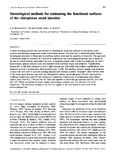Stereological methods for estimating the functional surfaces of the chiropteran small intestine.

View/
Date
1995Author
Makanya, AN
Mayhew, TM
Maina, JN
Type
ArticleLanguage
enMetadata
Show full item recordAbstract
A tissue sampling protocol has been devised for studying the functional surfaces of chiropteran small
intestine and drawing comparisons within and between species. The goal was to obtain minimally biased
stereological estimates of villous and microvillous surface areas and the numbers of microvilli. The approach
is illustrated using the intestines of 3 bats (from frugivorous and entomophagous groups) and is based on
the use of vertical sections and cycloid test arcs. A sampling scheme with 3 levels was employed. At level 1
(macroscopy), primary mucosal area was estimated from intestinal length and perimeter. Amplification
factors due to villi were estimated at level 2 (light microscopy, LM) whilst microvillous amplifications were
estimated at level 3 (transmission electron microscopy, TEM). The absolute surfaces, lengths and diameters
of microvilli were used to calculate packing densities and absolute numbers. Estimated villous surface areas
of the entire small intestine were 44.4 cm2 (Miniopterus inflatus, entomophagous), 410 cm2 (Epomophorus
wahlbergi, frugivorous) and 237 cm2 (Lisonycteris angolensis, frugivorous). Corresponding microvillous
surface areas were 0.11, 1.69 and 1.01 m2 whilst the numbers of microvilli per intestine were 4.5, 23.4 and
8.8 x 1011. When normalised for body weights, microvillous surfaces were 122, 246 and 133 cm2/g
respectively. The functional surfaces of the fruit bat appear to be more extensive than those of the
entomophagous bat.
URI
http://www.ncbi.nlm.nih.gov/pmc/articles/PMC1167431/pdf/janat00130-0100.pdfhttp://erepository.uonbi.ac.ke:8080/xmlui/handle/123456789/50104
Citation
J Anat. 1995 October; 187(Pt 2): 361–368.Publisher
Department of Veterinary Anatomy, University of Nairobi Department of Human Morphology, University of Nottingham, UK.
